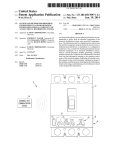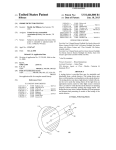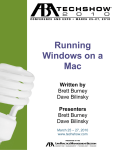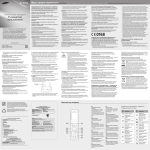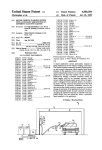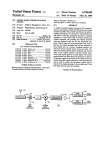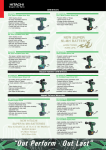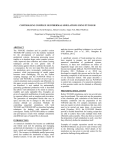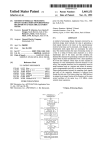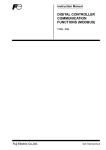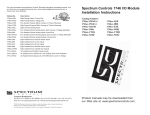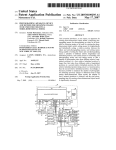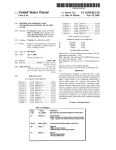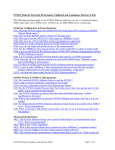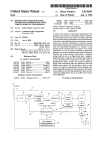Download l|||||llllllllIllllllllllllllltllllllgmlgllllllllllllllllllllllllllllll
Transcript
l| | |l l l l Il l l l l l l ltl l l gmlgl l l l l l l l l l l l l l l United States Patent [191 [11] Patent Number: Bailey et al. [45] Date of Patent: [54] LOW POWER ARCHITECTURE FOR 5,159,765 10/1992 5,170,490 12/1992 5,175,759 12/1992 5,241,537 8/1993 PORTABLE AND MOBILE TWO-WAY RADIOS [75] Inventors: Dissosway; Timothy E. Russell Dailey; L. Marc Croucher, A. all of 7/1994 Jan. 23, 1996 Critchlow ................................ .. 455/76 Cannon et al. Metroka .... .. . ... . . Gulliford et al. Sobti 5:327:55“) 5,487,181 . ,... .... ... . Nickel et al. .. . 455/343 . . . . . . .. 379/58 .. 370/1102 . . . .. 455/38.3 379/58 Vignali et a1. .......................... .. 455/15 Forest, Va. FOREIGN PATENT DOCUMENTS [73] Assignee: llilli'cicsiglrrilcilljiurltg/logge Communications 0034542 3/1980 Japan ................................... .. 455/343 OTHER PUBLICATIONS Appl. No.: 969,739 “M-PD System . . . 136—174 MHz Personal Two-Way FM Filed: Radio Combination”; Maintenance Manual; GE Mobile Oct. 28, 1992 Communications; LBI—31629A, May 1987. Int. Cl.6 ...................... ...... .. H04B 1140; H04B 7/32 Hitachi H8/532 HD6475328, HD6435328 U.S. Cl. ............................ .. 455/89; 455/90; 455/343; Manual (Jan. 1992). Hardware 364/2286; 364/2302; 364/DIG. 1 Hitachi Single-Chip Microcomputer H8/330 HD6473308, Field of Search .................................. .. 455/38.3, 343, HD6433308 Hardware Manual-User’s Manual (Dec. 455/89-90, 73, 76, 183.2, 127; 379/58; 1989). 345/89, 148; 370/1102; 36402844538662, Primary Examiner_chi H. Pham Attorney, Agent, or Firm—Nixon & Vanderhye References Cited [56] [57] U.S. PATENT DOCUMENTS 4,384,361 4,437,095 4,562,307 ABSTRACT An extremely compact, full featured portable radio archi tecture conserves power by allowing a processor to sleep except when it needs to perform tasks. A lower power processor which acts principally as an interrupt controller but which performs other functions as well (e.g., tone 5/1983 Masaki .................................... .. 455/31 3/1984 Akahori et al. . 12/1985 Bursztejn et al. 340/825.44 .... .. 379/61 4,598,258 7/1986 4,731,814 3/1988 Becker et al. .. 379/62 decode, synthesizer lock monitoring, etc.) so the main 4,830,832 4/1989 Nagata et al. .. 455/343 processor can sleep as much as possible and yet is assured 455/76 .... .. 455/76 of being awoken promptly when its processing power is required. The resulting portable radio has extremely low power consumption (e.g., on the order of 75 milliamperes during trunked mode operation)—thereby permitting even a 4,870,699 4,887,311 12/1989 12/1989 Babano ..... .. . 331/14 Garner ......... .. Garner et al. 4,901,036 2/1990 Herold et al. 455/183 2 4,903,319 2/1990 Kasai et al. . 455/33 4,947,454 8/1990 Garner 455/88 4,979,102 12/1990 Tokuume 364/200 relatively small battery pack to provide nearly 8 hours of _ _ mmmumls 0Paramou The portable radio with battery is 5,001,776 455/343 small and lightweight enough to ?t into a front shirt pocket. 4,977,611 12/1990 3/1991 Maru .... .. 455/161 Clark .... .. 5,058,203 10/1991 Inagarm 5,109,537 455/89 35 Claims, 14 Drawing Sheets 4/1992 Toki ...................................... .. 455/343 ‘r56 5? l DISPIA‘7‘] "1"‘ "3: $155 w, 120'\_\ TJP ‘l L. _J 1360:‘ : 2K EEFHOM RCP 136!) mm 102\ 1350 118 \ ASP 124 UDC CTRL RF SECTION BK 1112 US. Patent Jan. 23, 1996 Sheet 1 of 14 l 60 5,487,181 US. Patent Jan. 23, 1996 Sheet 2 of 14 FIG 3 5,487,181 US. Patent Jan. 23, 1996 Sheet 4 of 14 5,487,181 FIG 5 0000 8000 32K MASKED ROM ~14O 8K RAM F800 F900 FA00 F800 F880 FF80 1 0000 FUTURE RAM EXPANSION VG DES CHIP VG DSP CHIP DUAL PORT RAM ASIC N108 1K RAM INTERNAL REGlSTERS spare 20000 spare 40000 64K FLASH EEPRQM 50000 80000 FUTURE FLASH EXPANSION spare L_______________i ~114 US. Patent Jan. 23, 1996 Sheet 5 0f 14 5,487,181 =2 Om: Em NE VI AI “09 5Iwvm6n m v_vIAz<|1m IAvI ‘sSImAE9a2vo8EI mm.\81in. K62AI AEPI; VA60I WIv SvE2I8m . I.A652I8 I~ U Iv wImAvaIg o(mM@IA0_.v8\I0 1IAI35 Iv V.I VI Ivwon. Iv mDQ< POwO NOwU mOmU .wO mOwO US. Patent Jan. 23, 1996 Sheet 6 of 14 5,487,181 1500 CONTROL REGISTERS 1550b FAR FBR FCR \ / DATA OUT FIG 6’ US. Patent Jan. 23, 1996 Sheet 8 of 14 5,487,181 FIG I0 WAKE UP SEQUENCE NMI _|'—L______ IRQ ____r——— IT CLOCK _.I_L_I_L__I_I__I_L_I_I_I"I. RCP INTERNAL ___I_I_]"I_F'I_I"I_I_L <5 <5 w CLOCK STABILIZATION TIME FIG II IT CLOCK RCP INTERNAL _____"—_| MW US. Patent Jan. 23, 1996 Sheet 9 of 14 5,487,181 202 200 /ANY os\ YES PROCESS TASK <TASKS READY YE <—'-S-<PEFIIPHERALS ‘RUNNING? FIG I2 DETERMINE SHORTEST TIME TASK WILL WILL BE AWAKED BY PROCESS INT THAT WOKE CPU 208 US. Patent Jan. 23, 1996 5,487,181 Sheet 10 of 14 SSBY SLEEP ISSUE WAKEUP CALL TO ICP WITH MINIMUM FIG I3 DISABLE INTS AND SAVE CPU STATES 220 224 CLEAR ASIC TIMER, SWITCH TO NMI INT 226 CPU SSBY SLEEP 228 UPDATE SYSTEM TIMERS WITH THE TIME THE CPU WAS ASLEEP 230 RESTORE CPU STATES AND ENABLE INTS 232 US. Patent Jan. 23, 1996 Sheet 11 of 14 5,487,181 FIG I44 MRK CHANNEL GUARD DECODE ENABLE TIMER CAPTURE WITH BUFFERING AND DO NOT ENABLE INPUT CAPTURE 300 FLAG (ICF) INTERRUPT LAST-TIME = O CURRENT_-SLOT = O 302 REMAINDER = O SLOT = NUMBER OF FRT COUNTS EQUAL TO TIME DETERMINED BY 1/8 CHANNEL GUARD PERIOD RESET FRT START F RT 304 US. Patent Jan. 23, 1996 Sheet 12 of 14 5,487,181 FIG I45 MRK CHANNEL GUARD DECODE USING FREE RUNNING TIMER READ FRT CURRENT__TIME = FRT DELTA = CURRENT__TIIVIE — LAST___TIME 308 LAST__TIME = CURRENT__TII\/IE NEW__SLOT = DELTA + CURRENT_SLOT * SLOT + REMAINDER NEW__SLOT = NEW_SLOT—8 * SLOT NEW__SLOT = NEW__SLOT + 8 * SLOT CURRENT_SLOT = QUOTENT OF NEW__SLOT / SLOT REMAINDER = THE REMAINDER OF NEW__SLOT / SLOT PASS CURRENT_SLOT TO CHANNEL GUARD 32o 310 318 US. Patent Jan.23, 1996 Sheet 13 of 14 5,487,181 FIG I5 LIMITEDXX FILTEREDCG SAMPLESTTTTTHTTTHTHTT SLOTS l1|2l3|4!5|e|7ls‘1lzlsl4ls‘el7lsl wk '<—_T—>| X SLOT TIME FIG I6 SYNTHESIZER LOCK DATA ENABLE WIDE WIDE / NARROW A NARROW LOCK DETECT |<_ TIME LOCK US. Patent Jan. 23, 1996 Sheet 14 of 14 5,487,181 FIG I7 SHARED SERIAL PORTS 102 104 RX TX RX TX 354 § 356) RX TX 124 FIG I5’ BOARD TYPE 5V gm / ‘130 132 ---> REGISTER S/W 5,487,181 1 2 LOW POWER ARCHITECTURE FOR PORTABLE AND MOBILE TWO-WAY RADIOS power more powerful lamp for the same amount of time). However, the larger “D” cells are also several times more bulky and heavy as comparedto penlight cells. If the amount of current continually being drawn by a radio from the battery can be decreased, then the radio can operate for a FIELD OF THE INVENTION longer time on a single battery charge. Moreover, very low The invention relates to improvements to radio transceiv~ ers, and more particularly, to features for reducing the power consumption of a portable and/or mobile two-way radio. BACKGROUND AND SUMMARY OF THE INVENTION current consumption means that even a relatively small battery can be used to provide relatively long periods of operation. 10 Unfortunately, the sophisticated features provided on today’s two-way radios require large amounts of software. This software can best be developed and maintained using high level languages such as C. However, these languages require high performance microcontrollers for proper execu Most people have at least seen, if not actually used, a hand-held (“walkie'talkie”) portable two-way radio. Hand held radios have revolutionized the way some people work. For example, a police officer can bring a handheld radio tion speed. These controllers require a great deal of current. when investigating on foot——thereby increasing safety and microcontrollers, but such constructions prevent the use of Some past designs have used multiple low performance high level languages and their advantages in development time and maintainability. Other designs have used a single effectiveness due to the ability to instantaneously commu nicate with a dispatcher or other police o?icers. Fire and low power rnicrocontroller with custom hardware. This solution su?fers from the same problems as multiple low performance controller technique, and also is not very ?exible since the functions of the custom hardware become ?xed once the custom hardware design is ?nalized. Other Smaller is generally better when it comes to hand-held 25 prior art designs may use the “sleep mode” of a processor to radios. Smaller radios are more convenient to carry, reduce turn off the CPU, but may keep the peripherals running. user fatigue, and may be able to go places that larger radios The present invention, in contrast, provides a miniaturized cannot go. For example, undercover police officers are not two-way radio design providing the performance offered by able to carry large two-way radios since such radios could be a high power CPU while also providing low current con— easily seen and thus “tip off” criminals and others under sumption. This low current consumption permits even a very investigation. A radio small enough to ?t into the officer’s small battery pack to power the radio for an entire (approxi front shirt pocket could be concealed underneath a normal rescue workers, paramedics, power and telephone company ?eld technicians, and other people performing tasks critical to general safety and welfare greatly bene?t from hand-held two-way radios. mately 8 hour) shift. As a result, the radio with battery jacket and thus could actually be carried by the police officer during covert and undercover operations. The ability of a connected is light, lean and super compact. The preferred Recent innovations in custom chip design allow radio embodiment radio is the ideal portable for covert operations and any other applications where concealed and/or extremely miniaturized radios are required. For example, the preferred embodiment weighs less than 20 ounces (including battery), is slightly more than 1 inch deep, and is slender and lightweight enough to slip into a front shirt pocket. designers to eliminate circuits, reduce the number of com ponents and cut power drain. Thus, it is now possible to provide a full-featured digital radio transceiver in a very embodiment of the invention include: Distribution of radio functions between a high-power} police o?icer to carry such a two-way radio while under cover would greatly increase the o?icer’s safety and under cover operations. However, various problems have in the past prevented such a compact full-featured radio from being widely produced. Features provided by the presently preferred exemplary small, low pro?le package. However, battery miniaturiza tion has not kept up with advances in semiconductor min 45 iaturization. Whereas only a few years ago the size and weight of the battery constituted only a small percentage of the overall size and weight of a hand-held radio, the battery may now comprise a signi?cant percentage (on the order of half) of the radio’s size and weight. Hand-held radios have long been powered by removable rechargeable battery packs that attach to the lower portion of the radio housing so as to become part of the radio hand grip. Such detachable reusable battery packs allow users to easily swap a recharged battery for a “dead” battery pack. The “dead” pack may then be recharged without removing the radio from service during the recharge procedure. Once cessor can be placed into a “software stand by” mode much of the time (i.e., except when actually needed); 50 A current saving architecture for a radio using software standby (“SSB”) mode with ASIC support to switch from IRQ (maskable) to NMI (non-maskable) interrupt inputs; Main CPU reads watchdog timer to accurately maintain system (real) time despite intermittent lapses into the 55 charged, a battery pack should last at least as long as a typical work shift (e.g., eight hours) so that the radio user does not need to carry additional battery packs and/or swap batteries in the middle of a shift. As everyone who has ever bought a ?ashlight knows, larger batteries deliver more current and thus have a longer life (assuming constant current draw). For example, a size “D” ?ashlight cell delivers several times the amount of 65 current delivered by a much smaller “AA” penlight ?ash light cell, and may thus power a lamp for a longer time (or high-capability processor, a low-power/low-capability processor, and additional logic (e.g., an application speci?c integrated circuit) so that the high-power pro~ sleep mode; A free running timer performs channel guard decode thus allowing simultaneous decode of channel guard and T99 signalling using the single low power processor; FIFO (?rst in ?rst out) data buffer so that the high-power processor can sleep; Pulse width modulator is used to control the backlight brightness of the LCD display and thus save current; Low power processor decodes “low speed” digital sig nalling so high-power processor can sleep; Low power processor monitors synthesizer lock line to allow high-power processor to sleep; 5,487,181 4 3 SSB is integrated into the high power processor operating system; Serial port is shared between micro-controllers to provide great ?exibility in design and current savings (i.e., allowing the low-power processor to handle serial messages while allowing the high-power processor to sleep); and Board type resistors identify the type of board. DETAILED DESCRIPTION OF THE PRESENTLY PREFERRED EXEMPLARY EMBODIMENT 5 FIG. 1 is a front elevated view of a presently preferred exemplary embodiment of a two-way portable hand-held radio transceiver (“radio”) 50 provided by the present inven tion. Radio 50 includes a main unit 52 and a detachable battery pack 54. Main unit 52 includes all of the electronics 10 BRIEF DESCRIPTION OF THE DRAWINGS (both digital control and radio frequency) required for two-way RF communications. Battery pack 54 is detachable and houses one or more rechargeable (e.g., NICAD) batter These and other features and advantages of the present invention will be better and more completely understood by referring to the following detailed description of a presently preferred exemplary embodiment in connection with the ies that provide power for operating main unit 52. In the preferred embodiment, the battery pack may be provided in three different sizes for three different power lifetimes. Preferred embodiment radio 50 is lightweight and slender. The following are exemplary dimension and weight speci ?cations for main unit 52 and battery pack 54. drawings, of which: FIG. 1 is an elevated front view of a presently preferred exemplary embodiment of a portable two-way radio trans ceiver provided by the present invention; 20 FIG. 2 is an elevated side view showing the FIG. 1 radio and, for size comparison purposes, a pair of conventional Less Battery, Knobs and Antenna sunglasses; FIG. 3 is an elevated perspective view of the FIG. 1 radio resting within a user’s front shirt pocket; FIG. 4 is a high level block diagram of an exemplary architecture of electronics within the FIG. 1 radio; FIG. 5 is a schematic diagram of an exemplary address space for the “RCP” processor shown in FIG. 4; FIG. 6 is an exemplary block diagram of the ASIC shown in FIG. 4; FIG. 7 is a schematic diagram of an exemplary modem, buffer and control register architecture of the FIG. 6 ASIC; FIG. 8 is a conceptual schematic diagram showing exem M-RK II (Display + keypad) With High Capacity Battery M-RK II: 7'' X 2.7" X 1.16" 176.8 x 68 mm x 40.6 mm M-RK I: 7'' X 2.7“ X 1.18“ 176.8 X 68 mm x 30 mm 35 WEIGHT M-RK II (Less Battery): M-RK I (Less Battery): 10 oz (258 g) 8.8 oz (250 g) BATTERIES CAPACITY processor; Medium 45 being “awakened” by the ASIC; FIGS. 14A-14B together are schematic ?owcharts of the FIG. 4 ICP processor; 4" X 2.7" X 1.18" 101 mm x 68 mm X 30 mm FIGS. 10—11 are timing diagrams showing exemplary wake-up and sleep sequences, respectively, of the RCP exemplary channel guard detection technique performed by 101 mm X 68 mm X 40.6 mm M~RK I (No Display + keypad) FIG. 9 is a detailed block and schematic diagram showing exemplary interrupt control structure for the FIG. 4 ASIC; exemplary program control steps performed by the FIG. 4 low-power ICP processor in order to provide channel guard decode using a free running timer; FIG. 15 is an exemplary timing diagram showing the 4“ x 2.7" x 1.6“ 25 plary operation of the buffer shown in FIG. 7; FIG. 12 is a schematic ?owchart of exemplary operating system control steps performed by the RCP processor shown in FIG. 4; FIG. 13 is a schematic ?owchart of exemplary program control steps performed by the FIG. 4 RCP processor upon 7.5 VDC (nominal) INPUT VOLTAGE: DIMENSIONS (Typical) H X W X D 50 DIMENSION (H x W X D) WEIGHT 2.54" x 2.7" X 1.1" 6.4 oz. 64.6mmx68mmx28mm 163g High 3.1“ X 2.7" X 1.1" 10.4 oz. 79.6mmx68mmx28mm 296g Extra High: 3.8“ X 2.9" X 1.1" TBD The radio shown in FIG. 1 includes an LCD display and a keypad 58. However, as indicated in the dimension/weight speci?cation set forth above, in another embodiment the display 56 and keypad 58 may be omitted (with several light emitting diode indicators being used in lieu of the display) so as to provide an even smaller: depth and reduced weight. 55 FIG. 16 is an exemplary timing diagram showing the synthesizer lock detect performed by the low-power ICP processor shown in FIG. 4; FIG. 17 is a high level block diagram showing an exem Without display 56 and keypad 58, radio 50 is so slim that it may easily be inserted into a front shirt pocket (see FIG. 3). Even with the display and keypad, the radio 50 is extremely slim and trim (see the side view of FIG. 2). The following is a list of a few of the salient advantageous features of the radio 50 shown in FIG. 1: plary serial port sharing arrangement between the high power and low-power processors RCP and ICP shown in FIG. 4; and FIG. 18 is a schematic and block diagram showing an exemplary preferred technique provided by the preferred embodiment of the present invention for detecting board type. 65 PRODUCT FEATURES MAI OR BENEFITS Small size and light weight Easy to carry, easy to conceal and easy to use. Top mounted rotary Convenient Eyes Free operation controls while worn on the belt. 5,487,181 PRODUCT FEATURES 5 6 -continued interaction with RCP 102 and ICP 104 will be described in more detail shortly. Main unit 52 further includes an optional display proces sor 120 connected to LCD display 56. Display processor 120 MAJOR BENEFITS Two line dot matrix Clear display of system and group LCD (M-RK 11) information. Ideal for in the preferred embodiment comprises an intelligent LCD display controller of conventional design including a four bit micro-controller and integral LCD driver. This approach Alphanumerics. Characters invert 180° for easy-to-read viewing while worn on the belt. System keypad Provides access to system and radio (M—RK II) features like individual calls, off loads many of the tedious display functions from RCP 102—allowing the RCP to sleep more. Display 56 in the preferred embodiment comprises two rows of eight charac ters using dot matrix characters. scan, and menu select. Backlit for night viewing. Remote radio disable Allows dispatcher to “Kill” an EDACS radio in the event it is reported lost or stolen. Emergency button lrnmediate signalling of emergency condition including user ID to 15 alert dispatch center and group users. EDACS signalling Conventional signalling Includes all the bene?ts of EGE’s EDACS fault tolerant communication. Includes GE STAR ID/Emer— gency and TYPE 99 decoding for conventional radio ID and signals over the air via antenna 60. RF section 122 receives and detects RF signals at frequencies selected by synthesizer 117 and provides the detected audio to ASP 118 for ?ltering and further processing. A conventional microphone, loud individual calling. FIG. 4 is a schematic diagram of an exemplary architec ture of radio main unit 52 shown in FIG. 1. Main unit 52 speaker and associated ampli?cation circuitry (not shown) is 25 includes a high-powered radio control processor (“RCP”) 102; a lower-power interrupt control processor (“ICP”) 104; and a custom application speci?c integrated circuit (“ASIC”) 108. RCP 102, ICP 104 and ASIC 108 commu nicate with one another via a general-purpose conventional example, frequencies of operation, radio identi?cation, access memory 112, ?ash memory 114, and a digital voice group and individual IDs, and the like. guard block 116, all of conventional design. Voice guard module 116 provides encrypted voice communications. This module is of conventional design and communicates with used to convert user’s speech into audio signals and to convert received audio into sound for listening by the user. A universal device connector (“UDC”) 124 provides a digital serial port for coupling with the outside world. UDS 124 may be used, for example, to load new “personality” programming into the radio 50 from an external program ming source. Such “personality” de?ning data speci?es, for address/data bus 110. Also connected to bus 110 are random RCP 102 via the address/data bus 110. RF section 122 performs all of the radio frequency signal processing within main unit 52. RF section 122, for example, modulates a radio frequency signal (generated at a frequency controlled by a conventional frequency synthe sizer 117 under the control of ICP 104) with audio received from ASP 118 (or digitized audio received from voice guard block 116). RP section 122 transmits such modulated RF 35 ' ICP 104 ICP 104 in the preferred embodiment is a masked H8/33O RCP 102 in the preferred embodiment comprises a Hita chi H8/532 micro-controller. RCP 102 is the high perfor mance CPU coordinating all of the functions of main unit 52. ICP 104 in the preferred, embodiment is a Hitachi high performance single chip micro-computer providing 16K bytes of on chip ROM, 512 bytes of on chip RAM, 15 bytes of dual port RAM (for master/slave interface), serial I/O, general purpose I/O ports, and A/D converter and internal timers. The main function of ICP 104 is to handle user interface interrupts and tone decodes so that RCP 102 H8/330 single chip micro-computer which acts as a smart interrupt controller for RCP 102. More information regard ing these conventional Hitachi processors may be found in can remain in a low power state as much as possible. ICP various publicly available printed publications, including the 104 is thus treated more as an intelligent interrupt controller than as another independent CPU within the architecture of Hitachi Single~chip Microcomputer H8/330, radio main unit 52. The functions performed by ICP 104 can HD6473308, HD66433308 Hardware Manual, ADE-602 be well de?ned and speci?ed by internal masked ROM O26(0), published (1st Edition) December 1989 (Hitachi programming. The interface and operation of ICP 104 is as Corp); and generic as possible to allow this component to support the 50 different requirements of a mobile radio and a portable radio; Hitachi H8/532, HD6475328, HD6435328 Hardware following: 45 Manual, M2lT0O2, published January 1992 (Hitachi Corp.) processor (ASP) 118 of conventional design that handles and to support minor design changes without re-masking. Therefore, ICP 104 is programmed as a con?gurable I/O device that can perform tone decode, keypad and U0 generated, for example. decodes, sub-audible tone encodes, low speed data decode, Main unit 52 further includes a custom audio signal most of the audio ?ltering for the radio. ASP 118 may be a 55 manipulation. ICP 104 is preferably con?gured by RCP 102 at time of power up of radio main unit 52. single chip device that is capable of powering down unused circuitry while continuing to generate alert tones. This The primary functions of the ICP are: key-pad scan, allows RCP 102 to sleep while the alert tones are being discrete I/O monitoring, display backlight control, tone‘ ICP 104 handles the user interfaces, performs tone decod 60 carrier detection/squelch control, RSSI monitoring, and syn thesizer control. ing, and controls radio frequency synthesizer 116 in the preferred embodiment. ASIC 108 contains circuitry which In connection with keypad scan, ICP 104 scans the keypad handles the transmission and reception of digital information 58 in a conventional manner to detect user depression of over the air. ASIC 108 further includes interrupt control keys, and also monitors group knob and volume knob settings (see FIG. 1). If a key is depressed (or a knob is turned), ICP 104 noti?es the RCP 102 via a dual port RAM message. circuitry, clock control circuitry and address decode logic. ASIC 108 is in some sense the “glue that holds everything together” in the preferred embodiment. ASIC 108 and its 65 5,487,181 7 8 The discrete I/O monitoring performed by ICP 104 includes monitoring the emergency and push-to-talk (“PTI‘”) buttons (not shown). These I/O signals are checked embodiment: MRK-I=ground, MRK-II=Vcc, and Delta 2:Vcc/2. Other voltage levels intermediate to Vcc and ground potential may be used to specify other board types if each time the keypad 50 is scanned. ICP 104 noti?es RCP 102 if one of the buttons is depressed. ICP 104 also monitors its UART for data from UDC 124. With regard to backlight control, ICP 104 includes an internal pulse width modulator timer module with two independent channels that are functionally identical. Each PWF channel generates a rectangular output pulse with a desired. FIG. 18 shows an exemplary resistive divider arrangement 130 that may be used to supply the analog voltage indicating board type. The V 2 output of divider 130 is coupled to an internal A/D converter 132 within ICP 104 (or RCP 102). The output of the A/D converter is read into a register 134 (also internal to the ICP or RCP), from which the register contents can be read by software. The software may branch or otherwise perform different functions depending on the register contents. This capability of ICP duty factor that is programmable from 0 to 100%. The duty factor is speci?ed in an 8-bit duty register (DTR). See page 171 et seq. of the above-referenced H8/330 Hardware 104 (RCP 102) to automatically detect and adapt to the type Manual. In the preferred embodiment, this pulse width of board or product in which it is installed allows a single “masked” processor to be used in a variety of diiferent modulator timer is used to control the brightness of a backlight 56a provided behind display 56. As is well known, LCD displays do not (unlike LED components) generate light but rather must rely on ambient lighting and/0r back products without requiring changes to the mask. lighting for readability. The preferred embodiment provides a backlight behind display 56 which may be activated by RCP 102 each time the user depresses a key of keypad 58. In the preferred embodiment, ICP 104 drives this backlight using one of its PWM outputs. The duty cycle of the PWM output thus controls the brightness of backlighting. The RCP 102 20 voice guard block 116, ICP 104, and IASIC 108 via data bus 110 (see FIG. 5, which schematically illustrates the address space of the RCP). In addition, RCP 102 has access to the backlight level is speci?ed by RCP 102 in the preferred embodiment. Using the pulse width modulator allows the ASP 118, EPROM 126 and display processor 120 via serial links 136A—136C. As mentioned above, RCP 102 in the preferred embodi intensity of the backlight to be varied by the user to select the lowest usable intensity to save power. With regard to tone encode and decode, ICP is capable of coding both channel guard and so called “T99” signalling simultaneously. Brie?y, T99 decoding is performed in a conventional manner, while channel guard decoding is per formed using an internal timer capture register. Further details regarding the channel guard decoding will be pro vided shortly. ICP 104 also performs channel guard and digital channel guard tone encoding using its two Walsh bits. This eliminates the potential risk that RCP 102 may not be able to successfully perform both DTMF and channel guard tone encoding simultaneously. With regard to low speed data decode, ICP 104 decodes EDACS conventional low speed data messages (which are substantially continually transmit ted subaudibly over assigned channels). ICP 104 does not try RCP 102 is the main processor for radio main unit 52. RCP 102 has access to the RAM 112, ?ash memory 114, ment is a Hitachi H8/532 microcomputer which runs at approximately 9.8304 megahertz or at some other value in multiple increments of 2.4576 megahertz (these frequencies were selected because they support the accurate generation of 38.4K baud data). It is preferable to use the slowest possible clock frequency because this reduces power con sumption and spurs. 35 The Hitachi H8/532 has the following features which are advantageously used in the preferred embodiment of the present invention: 16-bit internal architecture 8 l6-bit general purpose registers 32K bytes mask ROM 1K RAM 10-Bit A/D converter to determine the contents of the message, but instead simply passes each valid message to RCP 102 for processing. This allows the RCP 102 to sleep more often while nevertheless permitting the higher capability RCP to perform content Full duplex UART 3 l6-bit timers determinations. With regard to carrier detection and squelch control, ICP 104 performs these functions as part of its standard tone Watchdog timer 18-bit timer decode operations. ICP 104 in the preferred embodiment also supplies canier (i.e., squelch) information to RCP 102 3 pulse width timers to allow so-called “feature” tone decodes. RCP 102 is able Interrupt controller Current saving modes: Sleep mode DMA to tailor the responsiveness (slow/fast) of the squelch attack provided by ICP 104 (e.g., by writing parameters to the ICP). ICP 104 also is responsible for loading (programming) 55 synthesizer 117 and monitoring the lock status of the syn thesizer (as will be explained in greater detail shortly). In the preferred embodiment, ICP 104 also determines, based upon an analog voltage value applied thereto, the type Reduces current drain 30%. Software Standby Mode (SSB) Pulls nano amps. Turns oif CPU and peripherals. Maintains outputs but registers of onboard support of board or product in which the ICP is installed. Such determination may also be performed by RCP 102. This board type determination allows the ICP 104 (RCP 102) modules are reset to initial values. Maintains internal RAM/registers. software to adjust automatically to different hardware con ?gurations. In the preferred embodiment, the analog input signal is generated by a resistor divider network between Vcc and ground. The following exemplary board types have been de?ned with regard to ICP 104 in the preferred CPU sleeps, but peripherals continue to work. Wakes up from peripheral interrupts. Wakes up in 52 micro seconds from non-maskable 65 interrupt. RCP 102 and ICP 104 communicate with one another via a dual port RAM within ICP 104. The protocol for the data 5,487,181 9 10 exchange is de?ned in the H8l330 hardware manual. This on-chip dual port RAM is provided to permit access by both the CPU in the H8/330 chip and by a master CPU on another program and personality must be uploaded (e.g., from a personal computer program of conventional design via uni versal device connector 124). The new personality is added chip. The memory organization of main unit 52 will now be described in connection with FIGS. 4 and 5. Main unit in the preferred embodiment has a total of 9K of RAM—lK onboard RCP 102 and 8K on a RAM 112 connected via bus 110. This collection of RAM locations is available for variables, buffers, etc. RAM 112 is not battery backed up. RCP 102 has 32K of masked ROM 140 onboard. Using this masked ROM 140 saves current by eliminating the to the code and is downloaded into main unit 52. EPROM 126 is accessible via a IIC link 136B connected to RCP 102. EPROM 126 contains user con?gurable con tents that must be maintained throughout a power cycle. These parameters include, for example, volume, current group/system, stored phone numbers, etc. 10 ASIC 108 power consumed by reading ?ash memory 114. Masked ROM 140 contains the following program elements (selected because they are stable, independent and easy to ASIC 108 is basically a “glue chip” that integrates many miscellaneous functions. ASIC 108 provides the following test); Data transmission and reception using programmable sync character (i.e., barker) features: BIOS—Basic Input/Output System. All the routines that interface directly to the hardware. This provides a layer Sync character can have up to 4 bit errors of hardware independence. The application program calls BIOS routines to implement hardware dependent This allows the ASIC to get synchronized with the received data while the RCP sleeps 64 byte transmit/receive buffer functions. If the hardware changes, only the BIOS need change. The application does not know the difference. This allows the ASIC to receive or transmit data while the The BIOS includes the bootstrap loader to load new program code in the ?ash. Operating System-(event driven multi-tasking) 25 Routines that run continuously (this eliminates calls to ?ash memory and reduces current drain). Routines that require fast execution. Since the BIOS is masked, the preferred embodiment of RCP sleeps. Limited full duplex operation. Watchdog timer This timer can be read by the RCP 102. The RCP 102 uses this timer to keep track of how long it was asleep so that it can update its own timers which are turned off in software standby mode. the present invention provides a way to recover from many Interrupt control circuitry bugs that might crop up. This is done by using a BIOS vector table. The table contains a starting vector for each of the BIOS routines. The BIOS installs its vector table in RAM (e.g., internal RAM or external RAM 112) at power up. The This supports interrupts related to data transmission and reception and also ties the RCP 102 and ICP 104 together to allow the RCP to sleep. Clock control circuitry This circuitry divides the single system clock down so that the lowest possible clock rates are used by each device. applications program can overwrite the vector table to install 35 a di?erent BIOS routine. This allows bad routines to be replaced by new routines stored in ?ash memory 114. Address decode Interrupt routines are handled in a similar way in the FIG. 6 is a block diagram of an exemplary architecture for preferred embodiment. Interrupt vectors are stored in ASIC 108 shown in FIG. 4. The primary purpose of ASIC masked ROM 140. Interrupts jump through a RAM vector 40 108 is to off-load tasks from RCP 102 so that the RCP can to the actual internlpt routine. Information stored in ?ash spend as much time as possible in the low power state. This memory 114 has the capability of installing or replacing these interrupt routines. greatly reduces the current requirements of radio main unit Main unit 52 has, as mentioned above, 64K of ?ash EPROM 114 available (additional address lines on bus 110 are available for expansion to 256K if space and cost allow). Flash memory 114 is an EEPROM that must be erased in large blocks rather than a byte at a time. The use of ?ash memory 114 allows an entire program to be changed without integrated circuit”) for device 108 reduces printed circuit board space required and also reduces parts count. opening main unit 52, but single values (like current vol ume) cannot be changed individually. In the preferred embodiment, ?ash memory 114 contains the application 52. In addition, the use of an ASIC (“application speci?c As shown in FIG. 6, ASIC 108 includes a modem 150, a bidirectional ?rst-in-?rst-out (FIFO) buffer 152, a control register bank 154, an interrupt controller 156, a watchdog timer 158, an address decoder 160, and a clock controller 50 register bank 154 contains control and status registers, and program. This is the high level code that provides the user interface and otherwise de?nes the features and operations provided by radio main unit 52. In the preferred embodi ment, this application program is written in the C language and is compiled for execution on the H8/532. In the preferred embodiment, the ?ash memory 114 also contains a large part of the personality de?ning information described above. Flash memory 114 is not large enough to hold the entire personality de?ning data in the preferred embodiment. Therefore, any part of the personality de?ning 162. Modern 150 is of conventional design, and permits digital data to be sent and received over the RF link. Control is the interface point for RCP 102. RCP 102 can write to 55 and/or read from registers within control register bank 154 via address bus 110. The following is an exemplary de?nition of control reg isters within ASIC control register bank 154: Read/ Name MDCRl MDCR2 PMRl stored in the ?ash memory 114. The remaining personality de?ning data is stored in EPROM 126 where it can be easily 65 PMR2 MACR changed. This means that any time the personality data MRCR data that cannot be changed by the user or over the air is stored in the ?ash memory 114 needs to be changed, the Write Description W W W W R/W Modem Divide Control Register (low) Modem Divide Control Register (high) Pattern Match Register (low) Pattern Match Register (high) Match Control Register R/W Modem Receive Control Register




























